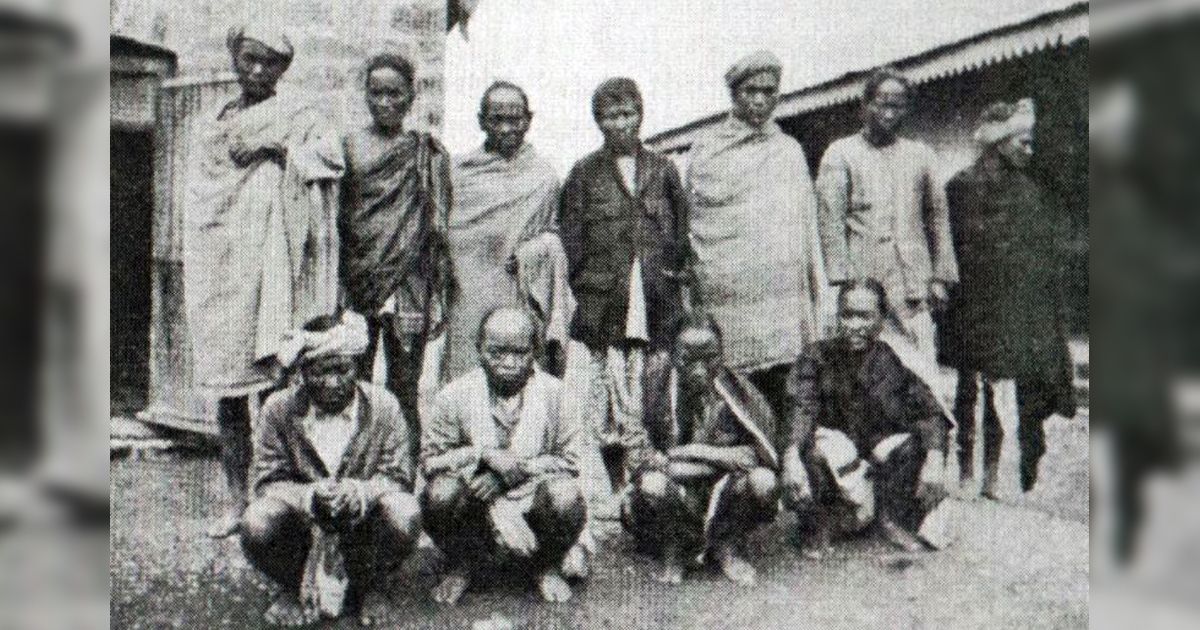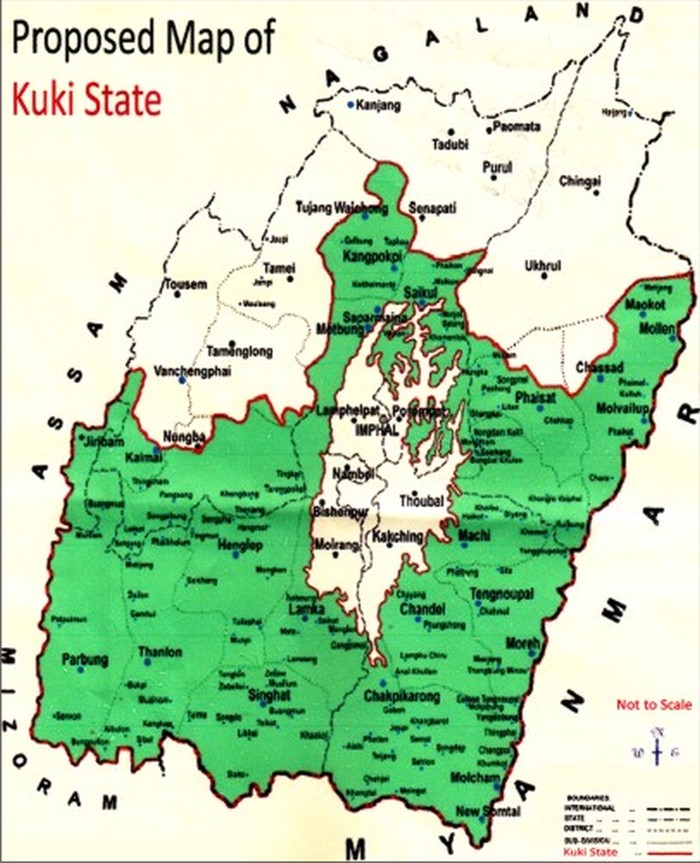
The 1917-’19 Anglo-Kuki war was the one of the biggest uprisings by the tribe against the colonial power.
Last week, the Centre held a third round of talks with Kuki rebels from Manipur. Delegates from the United People’s Front and the Kuki National Organisation, two umbrella organisations for Kuki militant groups, were closeted with officials from the Centre and the Manipur government at the Ashoka Hotel in Delhi. The Centre also appointed a new interlocutor for the talks, Dineshwar Sharma, former director of the Intelligence Bureau.
Meanwhile in Kangpokpi district in the Manipur hills, crowds marched in support of the talks, once again invoking the old Kuki demand for a separate state. For decades, the struggle for a separate homeland for Kukis has powered an armed insurgency in these hills. Scholar Seikhogin Haokip describes it as the “Kuki autonomy movement” or a battle for self-rule within the contours of the Indian Constitution, a state within a state with autonomies and protections under the Sixth Schedule . Yet, the roots of Kuki nationalism predate the Indian state.
Forged by war
The Kuki tribe is spread across states of the North East, parts of Myanmar and the Chittagong Hill Tracts in Bangladesh. But the map of the Kuki homeland has crystallised mainly around Manipur, covering large swathes of the hills that ring the Imphal Valley. Here, it overlaps with the imagined homeland of the Nagas, who have also fought a long and bloody battle for self-determination.
For both Naga and Kuki nationalisms, the First World War was a watershed moment.
During the War, the British was recruiting thousands of people from its empires to assist them in the war effort. The Nagas, were pressed into service as part of the Imperial Army’s Labour Corps, a vast body of men recruited to build roads, carry luggage and provide other kinds of logistical support.
This brought together different Naga tribes, many of whom had previously been at war with one another, and helped consolidate a pan-Naga identity. In 1918, a group of these soldiers formed the Naga Club, which would petition the British government for the right to self-determination in those decades before Independence.
For the Kukis, World War 1 was crucial because of their refusal to join the Labour Corps. The British had demanded recruits to the corps and the Manipur king promised 2,000 men. However, Kuki chiefs refused to join and instead declared war on the colonisers in 1917. The conflict that followed lasted for two years and claimed many lives. It has been variously called the “Great Kuki Rebellion”, the “Kuki Rising”, the “Anglo-Kuki War” and the “Zou Gaal”, depending on who is writing its history and when.
‘Marauding raids’
While the 1917-1919 Anglo-Kuki war was the one of the biggest uprisings by the tribe against the British, Kuki resistance first emerged in the 18th century, according to Haokip, when fighters from the hill tribe attacked British subjects in the Chittagong Hill Tracts. It intensified after the Treaty of Yandabo, signed in 1826 and bringing to an end the First Anglo-Burmese War. Under the Treaty, the Burmese signed away large tracts of what is now India’s North East, including Assam, Manipur and the hill areas, to the British. There were periodic Kuki raids on British subjects after that, in 1845, 1847-’48, 1849, 1850 and 1851. In the “Great Kuki Invasion of Tipperah” in the 1860s, 15 villages were burnt and around 185 British subjects killed.
British attitudes to the hill tribes stemmed from colonial ideas about the savage and the civilised, about which people were worthy of being governed and which people had to be deemed ungovernable. In Assam, a bureaucratic “Inner Line” cordoned off the tea gardens and other commercially promising regions from the “unadministered areas” inhabited by the hill tribes.

To thwart the periodic raids by hill tribes into their territories, the British built military capabilities. “The most obvious method of stopping these marauding raids was by retaliatory incursions into tribal territory,” wrote Bambfylde Fuller, in a foreword to History of the Assam Rifles, by LW Shakespear. Gradually, the British military police was fashioned into the Assam Rifles, which was in the first line of defence when the Kukis declared war in 1917.
Shakespear was then deputy inspector general of the Assam Rifles. Writing about the Anglo-Kuki conflict in the History… he said:
“It therefore grew into the largest series of military operations conducted on this side of India since the old (full-scale) Expeditionary days Generals Penn Symonds and Tregear in the late (eighteen) eighties, or the futile Abor Expedition of the 1911-12, eclipsing them all in casualties and arduousness of active service”.
In a column in the Sangai Express, writer Donn Morgan Kipgen adds that it was also the “longest, largest, costliest military operation in the whole of India since the Sepoy Mutiny of 1857”.
Declaring war
In January 1917, the British Indian government had ordered the Maharaja of Manipur to supply non-combatants to serve in the “Great War”. While several hundred were recruited from the Valley, the Kukis refused to comply and the various tribal chiefs held a series of conclaves. In March 1917, according to Kuki accounts, four chiefs from the tribe performed a ritual sacrifice that declared war. They were led by a fifth chief, Tintong, who became commander of the Kuki warriors.
The British marked out the region as “disturbed” and divided it up into six theatres of operation. The Assam Rifles and the Burma Military Police were deployed initially, but by November 2018, the British Indian Army had to be called in.
In two years of battle, it is said, there were short, sharp skirmishes between British troops and Kuki contingents. Some of these were face to face encounters but Kuki warriors also made use of guerrilla warfare tactics.
In the end, Kuki militias were outnumbered and worn down by the constant flow of British troops into the region. Kuki chiefs and leaders were jailed or exiled, writes Haokip, and the British launched a policy of “disarming” the martial tribe. Many of them were made to enter the begar system of forced labour and the British government began to take a closer interest in the previously “unadministered areas”.
But like the Naga tribes who came together in First World War France, Kuki unity was forged by the battles of 1917-1919. With Independence, regions considered Kuki ancestral lands were split up among the freshly minted nations of India, Burma and what was then East Pakistan. In 1946, the Kuki National Assembly, a pan-Kuki organisation, had already been formed to demand a single administrative unit.
War of Independence?
The decades after Indian Independence would see the Kuki movement become increasingly complex and splintered, not least because of the tensions within the pan-Kuki identity. But what of that brief movement between 1917 and 1919?
Colonial writers filed it away as a “rebellion” against enlisting in the Labour Corps, wrote Haokip, but “native scholars termed it a war of independence”. At one of the meetings in which the Kuki chiefs prepared for war, said Haokip, they declared this: “at all cost, we should fight against the British for the preservation of our independence, for the protection of our land, culture and tradition”.
At a speech made on the anniversary of the conflict last year, historian Lal Dena mentions links between the Kuki fighters and Bengali revolutionary nationalists. The partition of Bengal in 1905 had spurred the Swadeshi movement and nationalist organisations “sent their emissaries to the Kuki chiefs of the southern clans encouraging them to resist the high-handed methods of British colonial rulers…Therefore, Kuki people’s liberation movement in this part of the country in 1917 can be seen as an extension of the nationalist freedom struggle of the country,” concludes Dena.
Whether the two movements dovetailed so smoothly may be a matter of debate. But the Anglo-Kuki war throws up an unfamiliar picture of the freedom movement. Instead of one great tide of nationalism, it seems to become a bricolage of varied struggles, some of them unfulfilled. Yet each makes its claim on history, as if to say, “this too”.
Source: Scroll



